-
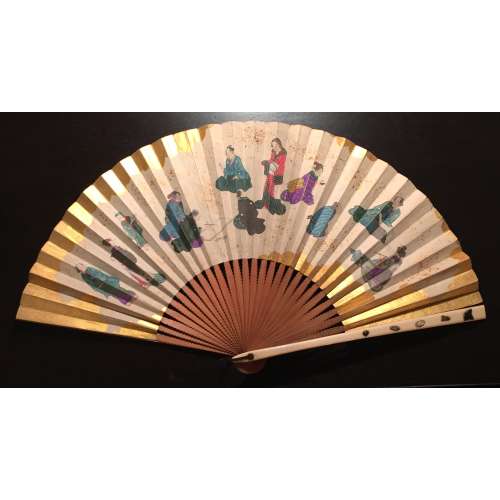 Late 19th-century (1850-1870) Japanese export fan. This fan has a double leaf painted with a different design on either side. Ivory encrusted with gemstones and other materials. Subject matter such as women wearing kimono is also more typical of export than domestic products (V&A). Autumn theme on the reverse.
Late 19th-century (1850-1870) Japanese export fan. This fan has a double leaf painted with a different design on either side. Ivory encrusted with gemstones and other materials. Subject matter such as women wearing kimono is also more typical of export than domestic products (V&A). Autumn theme on the reverse. -
 Shakudō tsuba of the slightly vertically elongated round form (nagamaru-gata) decorated by gold in flat inlay (hira-zōgan) with three insects (cricket, locust, and praying mantis), grass and dewdrops motif. Kogai hitsu-ana is plugged with gilded soft metal. Height: 70.2 mm; width: 66.4 mm x Thickness at seppa-dai: 4.5 mm. Edo period (from ca. 1700 to ca. 1850) Unsigned. Attributed to Kaga School or Murakami School. Almost identical tsuba (no dewdrops, though) is illustrated and described at page 60 of Kokusai Tosogu Kai. 7th International Convention & Exhibition, November 1st, 2011 at Tokyo National Museum, page 60. It is attributed to the Kaga School, Mid Edo period (Late 17th - early 18th century). Dimensions: 70.5 x 66 x 4.5 mm. "The rich black shakudo plate has been slightly lowered (dished out) and then polished. Gold insects crawl amongst grasses, depicted by Kaga style hirazogan (flat inlay). One tendril of the mantis overlaps onto seppa-dai. The mantis boldly looks out from the tsuba in a curious way. This style of Kaga tsuba was popular during the Genroku era (1688-1703)."Another source is Japanese Sword Fittings. A descriptive catalogue of the Collection of G.H. Naunton, Esq., completed and illustrated by Henri L. Joly, - 1912:
Shakudō tsuba of the slightly vertically elongated round form (nagamaru-gata) decorated by gold in flat inlay (hira-zōgan) with three insects (cricket, locust, and praying mantis), grass and dewdrops motif. Kogai hitsu-ana is plugged with gilded soft metal. Height: 70.2 mm; width: 66.4 mm x Thickness at seppa-dai: 4.5 mm. Edo period (from ca. 1700 to ca. 1850) Unsigned. Attributed to Kaga School or Murakami School. Almost identical tsuba (no dewdrops, though) is illustrated and described at page 60 of Kokusai Tosogu Kai. 7th International Convention & Exhibition, November 1st, 2011 at Tokyo National Museum, page 60. It is attributed to the Kaga School, Mid Edo period (Late 17th - early 18th century). Dimensions: 70.5 x 66 x 4.5 mm. "The rich black shakudo plate has been slightly lowered (dished out) and then polished. Gold insects crawl amongst grasses, depicted by Kaga style hirazogan (flat inlay). One tendril of the mantis overlaps onto seppa-dai. The mantis boldly looks out from the tsuba in a curious way. This style of Kaga tsuba was popular during the Genroku era (1688-1703)."Another source is Japanese Sword Fittings. A descriptive catalogue of the Collection of G.H. Naunton, Esq., completed and illustrated by Henri L. Joly, - 1912:
7-U17. Ron Hartmann Collection.
Kanazawa in Kaga was a centre of fine metal work during the whole of the Tokugawa period. At first the inlayers of Fushimi following the Daimyo Maeda went to Kanazawa, then some of the Gotō masters proceeded from Kyoto for short periods to work for the Daimyo, so that their influence was strongly impressed upon Kaga work..." A somewhat look-a-like tsuba is illustrated at plate XXVIII, Kaga Inlay, №653 with the following description at page 52: "Shakudō, inlaid with five insects in gold: crickets, praying mantis, grasshopper, in the style of Takagawara Ujitsugu.
According to M. Sesko, Ujitsugu was a master from Katsuki and Kaneko School in Kaga, son of Ujihira. Ujihira's father Ujiyoshi died in 1802. This brings us to the mid-19th century, instead of mid-18th or earlier. On the other hand, a very much look alike specimen at MFA collection (ACCESSION NUMBER 17.1061) has the with the following description: Edo period. Late 18th–early 19th century. Murakami School. Main material: shakudo; other metals: gold; decorative technique: iroe hirazogan.A detailed account of Murakami school can be found at The Japanese toso-kinko Schools.// Lulu Inc., 2012 by Markus Sesko, on pages 235-239. All-in-all, it's either Kaga School or Murakami School, either ca. 1700 or ca. 1850. Quite a range! SOLD
MFA # 17.1061
-
 Kozuka with seven insects (fly, grasshopper, bee, butterfly, dragonfly, firefly, and cricket) and grass with dewdrops motif. Shakudō, flush gold inlay (hira-zōgan). 95.2 (H) x 13.7 mm (W). Mid Edo period (Late 17th - early 18th century, Genroku era 1688-1703). Unsigned. Kaga school. A look-a-like kozuka (with five insects) is illustrated at Japanese Sword Fittings. A descriptive catalogue of the Collection of G.H. Naunton, Esq., completed and illustrated by Henri L. Joly, - 1912 on plate XXIX, №691 [LIB-1389 in this Collection] with the following description at page 54: "Shakudō, inlaid with butterfly, dragon-fly, grasshopper, locust and another insect, gold."
Kozuka with seven insects (fly, grasshopper, bee, butterfly, dragonfly, firefly, and cricket) and grass with dewdrops motif. Shakudō, flush gold inlay (hira-zōgan). 95.2 (H) x 13.7 mm (W). Mid Edo period (Late 17th - early 18th century, Genroku era 1688-1703). Unsigned. Kaga school. A look-a-like kozuka (with five insects) is illustrated at Japanese Sword Fittings. A descriptive catalogue of the Collection of G.H. Naunton, Esq., completed and illustrated by Henri L. Joly, - 1912 on plate XXIX, №691 [LIB-1389 in this Collection] with the following description at page 54: "Shakudō, inlaid with butterfly, dragon-fly, grasshopper, locust and another insect, gold." See also tsuba TSU-0211 in this collection:
See also tsuba TSU-0211 in this collection:


-
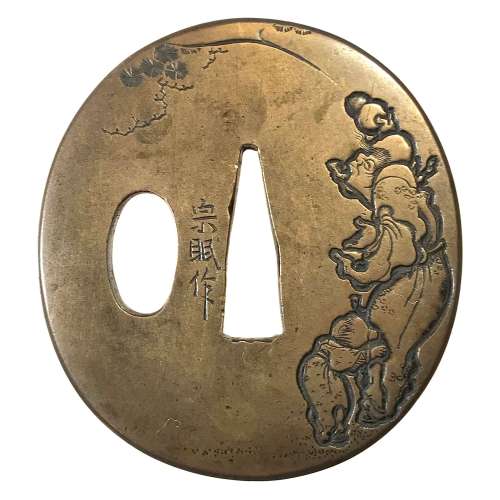
Sentoku tsuba of oval form with Sennin (Chinese immortal) motif carved in low relief (katakiribori). The Sennin is depicted with a double gourd in his right hand and a child beside his left hip. A pine tree carved on the reverse.
Signed: Sōmin saku (宗眠作) [M.Sesko]. Yokoya School (see The Japanese toso-kinko Schools by Markus Sesko, pp. 133-8).
Edo period (second half of the 18th century). Dimensions: Height: 61.6 mm; Width: 56.4 mm; Thickness: 4.2 mm; Weight: 85 g. -
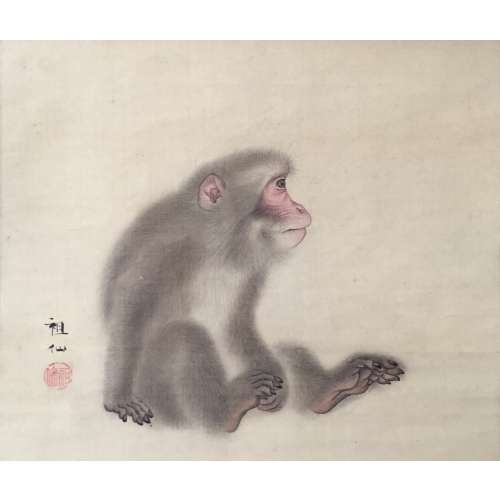 Mori Sosen (1747-1821). Seated Monkey. Hanging scroll painting. Ink and colour on silk. Signed: Sosen. Sealed: Sosen. 28.8 x 33.3 cm.
Mori Sosen (1747-1821). Seated Monkey. Hanging scroll painting. Ink and colour on silk. Signed: Sosen. Sealed: Sosen. 28.8 x 33.3 cm. -
 Saikotei Shibakuni (active 1821-1826). Osaka school. Play: Kinoshitakage Hazuma Gassen. Theatre: Nakamura-za /Naka-za (Osaka). Date: 7/1826. Horizontal oban diptych. SV: Nakamura Matsue III (Nakamura Tomijuro II) as female, Nakamura Utaemon III (Nakamura Shikan I) as a male. Publisher: Honya Seishichi [Marks 25-527 | 123f], Honsei, 1817-1838.
Saikotei Shibakuni (active 1821-1826). Osaka school. Play: Kinoshitakage Hazuma Gassen. Theatre: Nakamura-za /Naka-za (Osaka). Date: 7/1826. Horizontal oban diptych. SV: Nakamura Matsue III (Nakamura Tomijuro II) as female, Nakamura Utaemon III (Nakamura Shikan I) as a male. Publisher: Honya Seishichi [Marks 25-527 | 123f], Honsei, 1817-1838. -
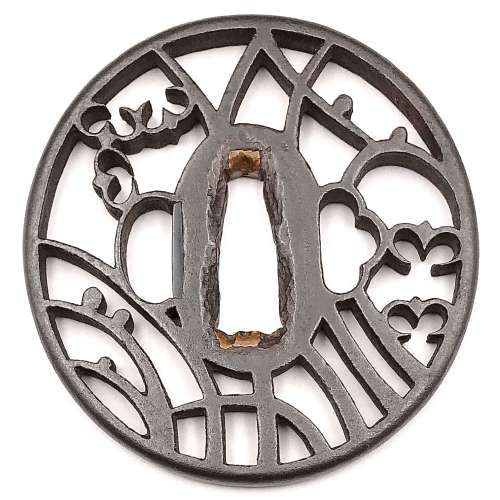 Iron tsuba of slightly elongated round form with design of wild geese and drops on pampas grass (masashino) in openwork (sukashi). Rounded rim. Copper sekigane. Owari school. Early Edo period: early 17th century (Kan-ei era). Height: 78.8 mm. Width: 76.3 mm. Rim thickness: 6.1 mm. Center thickness: 6.4 mm. Provenance: Sasano Masayuki Collection, № 169. A description of musashino symbolism can be found at Symbols of Japan by Merrily Baird [Merrily Baird. Symbols of Japan. Thematic motifs in art and design. Rizzoli international publications, Inc., 2001]: Musashino - "the plain of Musashi - a large expanse in the Tokyo area, was celebrated in poetry for the grasses that grew there before the recent era of industrialization... The use of Musashino themes was particularly common in the Momoyama and Edo periods". Pampas grass with dew drops and wild geese in flight collectively provide strong autumnal connotation.
Iron tsuba of slightly elongated round form with design of wild geese and drops on pampas grass (masashino) in openwork (sukashi). Rounded rim. Copper sekigane. Owari school. Early Edo period: early 17th century (Kan-ei era). Height: 78.8 mm. Width: 76.3 mm. Rim thickness: 6.1 mm. Center thickness: 6.4 mm. Provenance: Sasano Masayuki Collection, № 169. A description of musashino symbolism can be found at Symbols of Japan by Merrily Baird [Merrily Baird. Symbols of Japan. Thematic motifs in art and design. Rizzoli international publications, Inc., 2001]: Musashino - "the plain of Musashi - a large expanse in the Tokyo area, was celebrated in poetry for the grasses that grew there before the recent era of industrialization... The use of Musashino themes was particularly common in the Momoyama and Edo periods". Pampas grass with dew drops and wild geese in flight collectively provide strong autumnal connotation. -
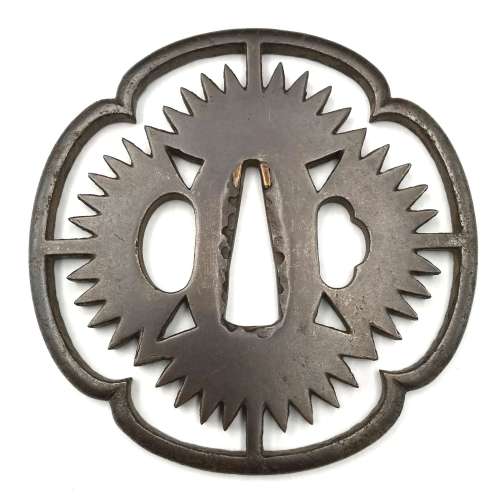 Iron tsuba of mokko form with slanting rays of light (shakoh) Christian motif (Jesuit's IHS symbol) in openwork (sukashi). Traditional description of this kind of design is called "tokei", or "clock gear". Owari school. Edo period.
Iron tsuba of mokko form with slanting rays of light (shakoh) Christian motif (Jesuit's IHS symbol) in openwork (sukashi). Traditional description of this kind of design is called "tokei", or "clock gear". Owari school. Edo period.Size: 83.4 x 83.1 x 4.4 mm
NTHK certified KANTEISHO ("Important Work"). In a custom wooden box. For information regarding shakoh tsuba see article 'Kirishitan Ikenie Tsuba by Fred Geyer at Kokusai Tosogu Kai; The 2nd International Convention & Exhibition, October 18-23, 2006, pp. 84-91. -
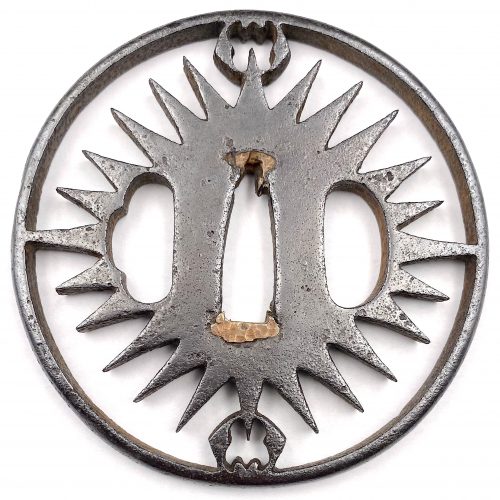 Iron tsuba of the round form (maru gata) with a grey patina pierced with the design of slanting rays of light (Jesuit’s IHS symbol) and a pair of ginger symbols [茗荷] (myōga) at top and bottom, in positive silhouette (ji-sukashi). This design is often called “tokei” [時計] or “clock gear”. Rounded rim, large hitsu-ana, copper fittings (sekigane). Unsigned, unpapered. Owari school. Early Edo period, early 17th century.
Iron tsuba of the round form (maru gata) with a grey patina pierced with the design of slanting rays of light (Jesuit’s IHS symbol) and a pair of ginger symbols [茗荷] (myōga) at top and bottom, in positive silhouette (ji-sukashi). This design is often called “tokei” [時計] or “clock gear”. Rounded rim, large hitsu-ana, copper fittings (sekigane). Unsigned, unpapered. Owari school. Early Edo period, early 17th century.Size: H 71.9 x W 71.1 x Th (centre) 5.5 cm.
For information regarding this type of tsuba see the article 'Kirishitan Ikenie Tsuba by Fred Geyer at Kokusai Tosogu Kai; The 2nd International Convention & Exhibition, October 18-23, 2006, pp. 84-91. 
IHS emblem of the Jesuits

茗荷 Myoga or Japanese ginger
-
 Iron tsuba of round form with design of double crossbar and two family crests (hikiryo-ni-kamon) in openwork (sukashi). Squared rim. Copper sekigane. Owari school. Early Edo period: Late 17th century (Kanbun / Enppo era). Height: 80.9 mm. Width: 80.8 mm. Rim thickness: 5.0 mm. Center thickness: 4.6 mm. Provenance: Sasano Masayuki Collection, № 172: "A paulownia and a clover are diagonally opposite two crossbars. This expressive design suggests a Higo origin, but the iron and the finish are certainly of the Owari school. Work of this nature may have been influenced by Hayashi Matashichi (1613-1699)."
Iron tsuba of round form with design of double crossbar and two family crests (hikiryo-ni-kamon) in openwork (sukashi). Squared rim. Copper sekigane. Owari school. Early Edo period: Late 17th century (Kanbun / Enppo era). Height: 80.9 mm. Width: 80.8 mm. Rim thickness: 5.0 mm. Center thickness: 4.6 mm. Provenance: Sasano Masayuki Collection, № 172: "A paulownia and a clover are diagonally opposite two crossbars. This expressive design suggests a Higo origin, but the iron and the finish are certainly of the Owari school. Work of this nature may have been influenced by Hayashi Matashichi (1613-1699)." -
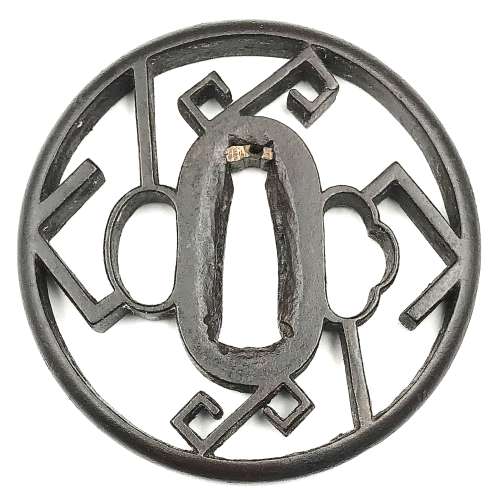
Iron tsuba of round form decorated with design of keys to the storehouse of the gods in openwork (sukashi). Rounded rim. Copper sekigane.
Unsigned. Early Edo period, 17th century.
Size: 71.0 x 70.9 x 6.0 mm.Merrily Baird, Symbols..: The Key to the Storehouse of the Gods, one of the Myriad Treasures.
-
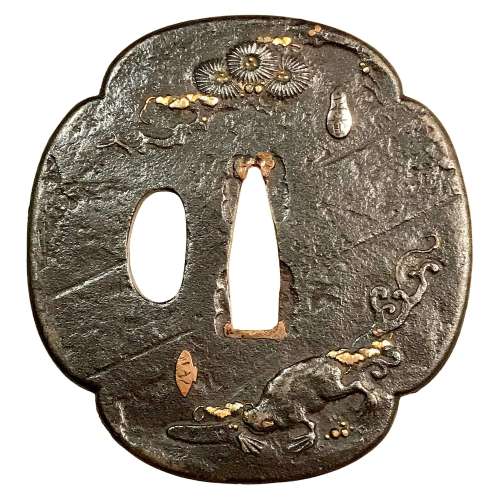
Iron tsuba of mokkō-form with a pine and a frog on the face and a snail on the back, carved and inlaid with gold. Each figurative element of the design is signed on three inlaid cartouches: Masaharu (正春), Kazuyuki (一之), and Yoshikazu (良一) [read by Markus Sesko]. Snake, snail, and frog together make a design called "SANSUKUMI" - Three Cringing Ones [Merrily Baird]. The snail can poison the snake, the frog eats the snail, and the snake eats the frog. It's unclear whether the pine replaces the snake on this tsuba, or the snake is hiding in the pine? Anyway, the frog and the snail are clearly represented. "Maybe we have here a joint work with Masaharu (the silver cartouche next to the pine) being the master and making the plate and Kazuyuki and Yoshikazu as his students carving out the frog and the snail respectively". Copper sekigane.
Dimensions: 70.9 x 67.2 x 3.0 mm. Edo period (18th century).Markus Sesko writes: "I agree, the frog and the snail most likely allude to the san-sukumi motif. It is possible that we have here an artist's choice to deliberately leave out the snake, maybe he thought that the motif is already obvious and there is no need to add a snake to make it clear that the tsuba shows the san-sukumi motif." [Markus Sesko].
Kazuyuki (一之): adopted son of Kumagai Yoshiyuki, student of Ichijō (Gotō-Ichijō Scool) [M. Sesko 'Genealogies', page 19.] Masaharu (正春): Kasuya fam., student of Masamichi (1707-1757) who was the 4th generation Nomura School master in Edo. [M. Sesko 'Genealogies', page 49.] -
 Iron tsuba of oval form with design of stylized paulownia (nage-giri) in openwork (sukashi). Leaf veins carved in kebori technique. Rounded rim. Copper sekigane. Unsigned. Attributed to Kanshirō, third generation Nishigaki (1680-1761). Edo period: Early 18th century (Kyoho / Genbun era). Size: Height: 77.8 mm. Width: 71.9 mm. Rim thickness: 5.9 mm. Center thickness: 5.0 mm. Provenance: Sasano Masayuki Collection, № 264: "Nishigaki. Third generation Kanshiro (died in in the eleventh year of Hohreki, 1761 at the age of eighty-two). This oblong shape appears a little amateurish at first, however, it was done intentionally to add flavor to to the design. The neat composition is a feature of the third Kanshiro."
Iron tsuba of oval form with design of stylized paulownia (nage-giri) in openwork (sukashi). Leaf veins carved in kebori technique. Rounded rim. Copper sekigane. Unsigned. Attributed to Kanshirō, third generation Nishigaki (1680-1761). Edo period: Early 18th century (Kyoho / Genbun era). Size: Height: 77.8 mm. Width: 71.9 mm. Rim thickness: 5.9 mm. Center thickness: 5.0 mm. Provenance: Sasano Masayuki Collection, № 264: "Nishigaki. Third generation Kanshiro (died in in the eleventh year of Hohreki, 1761 at the age of eighty-two). This oblong shape appears a little amateurish at first, however, it was done intentionally to add flavor to to the design. The neat composition is a feature of the third Kanshiro." -
 Iron tsuba of quatrefoil form with design of bamboo stems and leaves, and a plank bridge in openwork (sukashi). Hitsu-ana of irregular form. Iron with smooth chocolate patina. Copper and shakudō sekigane. This piece is illustrated in Sasano: Japanese Sword Guard Masterpieces from the Sasano Collection, 1994 on page 295 under № 254 with the following description:
Iron tsuba of quatrefoil form with design of bamboo stems and leaves, and a plank bridge in openwork (sukashi). Hitsu-ana of irregular form. Iron with smooth chocolate patina. Copper and shakudō sekigane. This piece is illustrated in Sasano: Japanese Sword Guard Masterpieces from the Sasano Collection, 1994 on page 295 under № 254 with the following description:Nishigaki. First generation Kanshiro (died in the sixth year of Genroku, 1693, at the age of 81). Sukashi design: Bamboo (take). Early Edo period, late 17th century (Kanbun / Enppo era). Height: 72.6 mm; Width: 71.5 mm; Rim thickness: .6 mm; Centre thickness: 5.1 mm. Rounded rim. The shape of this sword guard is a quatrefoil and the design is arranged in the form of a saddle flap. Two bamboo trunks with leaves comprise the design. Calm, soothing and sophisticated are the features of this artist in his later years. Such characteristics may remind one of the work of the first Hikozo.
Provenance: Sasano Masayuki collection, № 254. What is interesting, and what had been found by Bruce Kirkpatrick, is that in the earlier photograph of the same piece ['Sukashi tsuba - bushido no bi' by Sasano Masayuki, photography by Fujimoto Shihara, 1972 (in Japanese), page 245, №201] we clearly see kebori - linear carving that decorates the bamboo leaves and the planks of the bridge. The said kebori have totally disappeared between 1972 and 1994. The tsuba became absolutely flat! Now we can only speculate about the reasons for such cruel treatment of the artistically and historically important item.
Sukashi tsuba - bushido no bi. Author: Sasano Masayuki, photography: Fujimoto Shihara, 1972 (in Japanese). Page 245, №201.
-
 Iron tsuba of quatrefoil form with design of bamboo stems and leaves in openwork (sukashi) decorated with carving (kebori) . Copper sekigane. Early Edo period, late 17th century (Kanbun / Enppo era). First generation Kanshiro of Nishigaki school in Higo Province died in the sixth year of Genroku, 1693, at the age of 81). Height: 74.4 mm; Width: 74.2 mm; Centre thickness: 4.9 mm. Rounded rim. The design was quite popular among the Higo masters.
Iron tsuba of quatrefoil form with design of bamboo stems and leaves in openwork (sukashi) decorated with carving (kebori) . Copper sekigane. Early Edo period, late 17th century (Kanbun / Enppo era). First generation Kanshiro of Nishigaki school in Higo Province died in the sixth year of Genroku, 1693, at the age of 81). Height: 74.4 mm; Width: 74.2 mm; Centre thickness: 4.9 mm. Rounded rim. The design was quite popular among the Higo masters.
Kanshiro III, early 18th century (Sasano 1994 №267)

Matashichi I, late 17th century (Sasano 1994 №270)
The design of my tsuba closely resembles the one at the last example (Sasano 1994 №280), however, the form (mine is quatrefoil) and the execution (strength) are very different, which result in a very different spirit of my piece.
Shigemitsu II, early 18th century (Sasano 1994 №280)
-
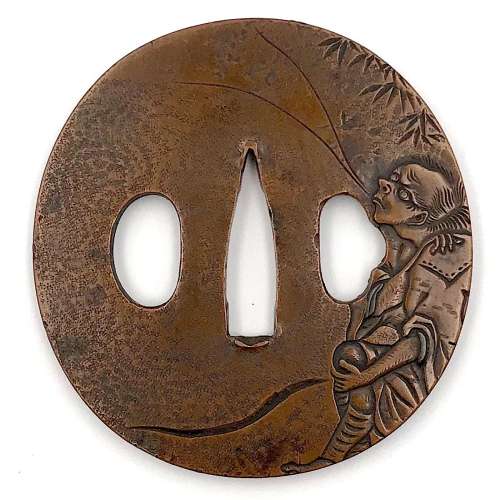
Copper tsuba of oval form carved in kebori and katakiribori with Tekkai Sennin sitting under bamboo on the face and with a pine tree on the back. Ishime-ji treated surface.
Signed on the reverse: Jōi (乗 意).
Edo period (First half of 18th century). Dimensions: 69.6 x 66.5 x 4.5 mm Sugiura Jōi (杉 浦 乗 意) was a master of Nara School in Edo; he was a student of Toshinaga [M. Sesko, 'Genealogies', p. 32]. "Sugiura Jōi (1701-1761) made many fuchigashira and kozuka, tsuba are rather rare." [M. Sesko, The Japanese toso-kinko Schools]. -

Copper tsuba of slightly elongated round form carved in low relief (shishiaibori and sukisagebori) and inlaid in gold, silver and shakudō with the design of dreaming Rosei (Lu Sheng): he is half-sitting by the pillow with his eyes closed, holding his fan, with a scroll by his feet, surrounded by flying butterflies.
Edo period, first half of the 18th century.
Dimensions: 70.8 x 67.1 x 5.0 mm. Signed on the reverse: Jōi (乗 意) + Kaō. Sugiura Jōi [杉 浦 乗 意] (1701-1761) was a master of Nara School in Edo; he was a student of Toshinaga [M. Sesko, ‘Genealogies’, p. 32]. “Sugiura Jōi (1701-1761) made many fuchigashira and kozuka, tsuba are rather rare.” [M. Sesko, The Japanese toso-kinko Schools, pp. 148-149]. On Rosei (Lu Sheng) dream's legend see Legend in Japanese Art by Henri L. Joly (1908 edition) on page 293. -
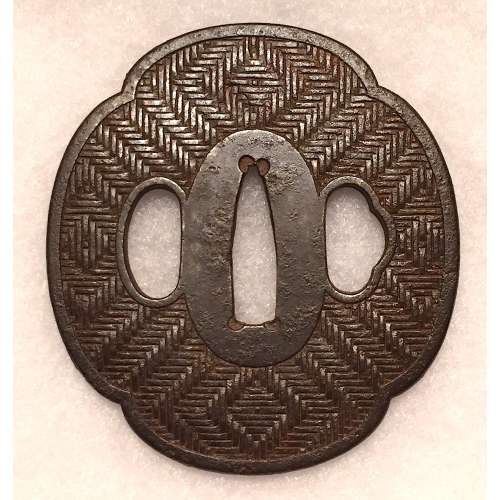 Iron tsuba with brown patina in mokkō-gata form with woven design. Size: 72 x 67 x 5 mm.
Iron tsuba with brown patina in mokkō-gata form with woven design. Size: 72 x 67 x 5 mm.


